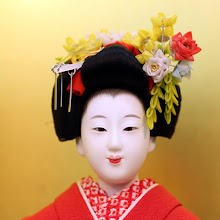Japanese dolls have always been a very important part of Japanese culture due to the fact that they are often created as part of household shines and as a way to give and receive blessings. In Japanese these dolls are called Ningyo which literally translates to human shape. The most prominent time when dolls are created and displayed in modern Japan is during the Hinamatsuri or the Japanese Doll Festival.
The tradition of creating dolls is steeped in Japanese culture with the earliest known records around 3 BC but it is suggested that this tradition may go even further back. In 3 BC it was written in the records of the Ise Temple that grass dolls would be made and blessed before being thrown into the river close to the shine. This tradition still continues today in the form of the Hinamatsuri in which dolls are created, placed into small boats and sent out to sea. This tradition is done to send away bad spirits and bring forth new blessings.
The ancient Jomon culture in Japan which reigned from 8000 – 200 BC was known to create humanoid figures but it is unknown if these dolls had the same significance that they would later have for the Japanese people. In the Kofun culture which lasted from 300 -600 AD it was customary to create funeral figures but this practice is largely extinct today.
In the early eleventh century Japanese dolls began to take on the form that they are known to have today. During the peak of Heian period there were a number of different types of dolls including dolls for play and dolls for protection. They were also used in religious ceremonies in which they would take on the sins of any person they touched.
It was during the Edo period from around 1603-1867 that the practice of artesian dollmakers developed. These dollmakers would strive to create sets of dolls that would be displayed in the homes of the rich. This practice continues to this day during the Hinamatsuri festival it is traditional for people to display a Hina set in their home. A traditional hina set consists of 15 Japanese Dolls which can differ from household to household but a usual set is done in a male-female pattern, often referred to as the Emperor and Empress.
The Japanese doll tradition has existed for thousands of years and is perhaps one of the longest lasting and most historical Japanese traditions. After centuries of perfection these dolls are now truly intricate and beautiful dolls, that are unmatched by any other.
Sunday, January 3, 2010
Subscribe to:
Post Comments (Atom)

Taking into account that these Japanese dolls have elaborate details, one can imagine a thousand years’ tradition of perfecting the skill of crafting these dolls. Particularly evident are the kimonos that perfectly resemble the real traditional dress. Such dolls’ clothes embody the beauty of handcrafted tradition emboldened by Japanese beauty.
ReplyDelete